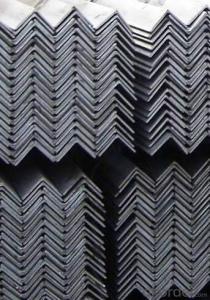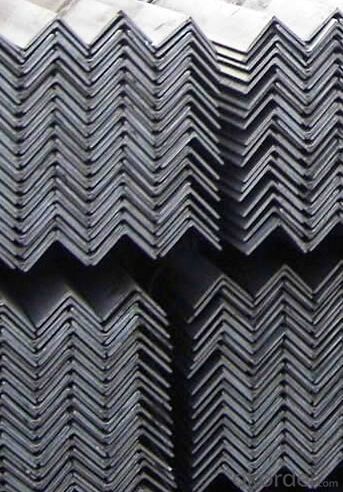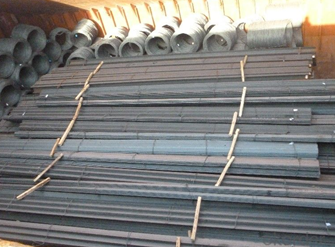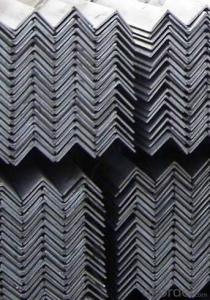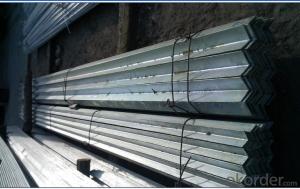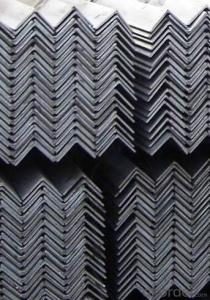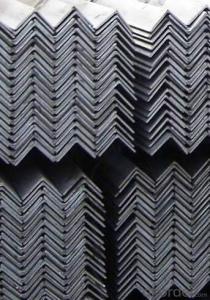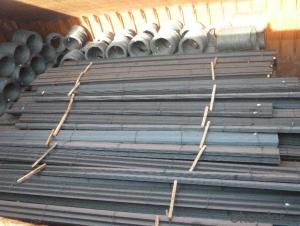GB STANDARD HIGH QUALITY HOT ROLLED ANGLE BAR
- Loading Port:
- Tianjin
- Payment Terms:
- TT OR LC
- Min Order Qty:
- 50 m.t.
- Supply Capability:
- 5000 m.t./month
OKorder Service Pledge
OKorder Financial Service
You Might Also Like
Product Description:
Specifications of Hot Rolled Steel Rebar:
The production process of Steel Rebar
1-Waling beam furnace 2-Roughing rolling group 3-Intermediate rolling train
4-Finishing rolling group 5-Water-cooling device 6-Walking beam cooler
7-Finishing equipment(including the cold scale shear,short feet collection system,
automatic counting device,bundling machine, collect bench)
Usage and Applications of Hot Rolled Steel Rebar:
Deformed bar is widely used in buildings, bridges, roads and other engineering construction. Big to highways, railways, bridges, culverts, tunnels, public facilities such as flood control, dam, small to housing construction, beam, column, wall and the foundation of the plate, deformed bar is an integral structure material. With the development of world economy and the vigorous development of infrastructure construction, real estate, the demand for deformed bar will be larger and larger..
Packaging & Delivery of Hot Rolled Steel Rebar:
Packaging Detail: products are packed in bundle and then shipped by container or bulk vessel, deformed bar is usually naked strapping delivery, when storing, please pay attention to moisture proof. The performance of rust will produce adverse effect.
Each bundle weight: 2-3MT, or as required
Payment terms: TT payment in advance or Irrevocable LC at sight.
Trade terms :FOB, CFR, CIF
Label:to be specified by customer, generally, each bundle has 1-2 labels
Note:
1. Our products are produced according to national standard (GB), if not, supply according to national standards (GB) or agreement as customer required.
2. Other Grade and Standard Deformed Steel Bar we can supply:
Grade: GR40/GR60, G460B/B500A/B500B/B500C,BST500S
Standard: ASTM, BS, DIN
The Minimum Order Quantity of these products is high, and need to be confirmed.
3. We can not only supply Deformed Steel Bar; if you need anything about building materials, please contact us for further information.
4. Please send us your detail specifications when inquire. We will reply to you as soon as possible. We sincerely hope we can establish a long stable business relationship.
- Q: Bearing capacity of angle steel and channel steel
- Angle called angle, the steel strip is perpendicular to each other on both sides into the corner. There are equal angles and unequal angles. The two sides of an equal angle steel are equal in width. The specifications are expressed in millimeters of edge width * edge width * edge thickness. Such as "/ 30 x 30 x 3", that is 30 mm width equal angle, edge thickness of 3 mm. Also available models that model is the number of centimeters wide, such as angle 3#. The model does not mean the size of the different edges and sizes of the same model. Therefore, the width, the edge and the thickness of the angle iron should be filled out in the contract and other documents, so as not to be indicated by the model alone. Standard Specification for hot-rolled equal angle iron is 2#-20#. The angle iron can be made up of different force components according to the different structure, and can also be used as the connecting piece between the components. Widely used in a variety of architectural and engineering structures, such as beams, bridges, towers, hoisting and conveying machinery, ships, industrial furnace, reaction tower, container frame and warehouse.Angle steel performance index: the performance test of angle iron is mainly tensile test and bending test. Indicators include yield point, tensile strength, elongation and bending compliance.
- Q: How do you transport steel angles?
- To ensure the safe delivery of steel angles, careful planning and proper equipment are necessary. The following guidelines can help you transport steel angles effectively: 1. Select the appropriate mode of transportation: Depending on the quantity and distance, there are various methods available for transporting steel angles, such as trucks, trailers, flatbeds, or shipping containers. Consider the dimensions and weight of the angles to determine the most suitable mode of transportation. 2. Secure the angles properly: It is essential to securely fasten the steel angles to prevent any movement during transit. Use sturdy straps, chains, or ropes to hold them in place and protect them from shifting or falling. Avoid over-tightening, as it can cause damage to the angles. 3. Implement protective measures: Steel angles are susceptible to rust and corrosion, particularly when exposed to moisture. To prevent this, consider using protective coverings like plastic wrap or tarps to shield them from rain, snow, or other environmental factors. Additionally, you can apply rust inhibitors or coatings for additional protection. 4. Ensure even weight distribution: It is crucial to distribute the weight of the steel angles evenly to avoid excessive strain on specific areas. Distribute the load evenly on the trailer or container to maintain balance and stability during transportation. 5. Proper loading and unloading: When loading and unloading steel angles, utilize appropriate lifting equipment such as cranes, forklifts, or hoists. Ensure that the equipment is capable of handling the weight and size of the angles. Follow correct lifting techniques and use specialized slings or clamps to prevent any damage during the process. 6. Obtain necessary permits and clearances: Depending on the size and weight of the steel angles and the chosen transportation method, you may need to acquire permits or clearances from relevant authorities. Check local regulations and ensure compliance to avoid any legal issues. 7. Plan the route and consider road conditions: Prior to transporting steel angles, carefully plan the route to avoid narrow roads, low bridges, or other obstacles that may hinder the safe passage of the load. Take into account road conditions, traffic congestion, and any necessary detours to ensure a smooth and secure transportation process. By adhering to these guidelines, you can transport steel angles safely and efficiently, minimizing the risk of damage and ensuring their timely delivery to the desired destination.
- Q: Can steel angles be used as bracing elements in a structure?
- Yes, steel angles can be used as bracing elements in a structure. They are commonly used to provide stability and support to structural systems, especially in applications where lateral forces need to be resisted. Steel angles offer excellent strength and rigidity, making them suitable for bracing purposes in various construction projects.
- Q: Can steel angles be used for sound barriers?
- Yes, steel angles can be used for sound barriers. Steel angles are commonly used in construction and can be suitable for sound barrier applications due to their durability, strength, and ability to absorb and block sound.
- Q: Can steel angles be used in the construction of shopping malls?
- Yes, steel angles can be used in the construction of shopping malls. Steel angles are commonly used in structural applications, including the construction of commercial buildings like shopping malls. They provide strength, stability, and support, making them a suitable choice for various structural elements such as frames, columns, and beams in shopping mall construction.
- Q: Can steel angles be used for manufacturing staircases?
- Yes, steel angles can be used for manufacturing staircases. Steel angles are commonly used as structural components in staircase construction due to their strength, durability, and versatility. They provide stability and support to the staircase framework and are often used as stringers or supports for the steps. Additionally, steel angles can be easily welded or bolted together to create a sturdy and reliable staircase structure.
- Q: What are the different types of steel angles?
- A variety of steel angles exist, each serving specific purposes and applications. Here are some common types: 1. Equal angle: Utilized for structural support, bracing, and framing in construction, this angle boasts equal sides. 2. Unequal angle: Also known as L-shaped or unequal leg angle, it features unequal sides, with one side longer than the other. It finds use in building construction for creating corners, edges, and supports. 3. Stainless steel angle: Crafted from stainless steel, this angle offers exceptional resistance to corrosion. It is commonly employed in environments exposed to moisture or chemicals, such as marine settings or food processing facilities. 4. Galvanized angle: These steel angles are coated with a layer of zinc to safeguard against rust and corrosion. They are frequently utilized in outdoor and industrial settings where durability is crucial. 5. Slotted angle: Equipped with holes or slots along its length, this steel angle facilitates easy attachment and adjustment of components. It is commonly found in shelving systems, storage racks, and DIY projects. 6. Rolled steel angle: Manufactured by rolling steel into a specific shape, it results in a smooth and uniform surface. Rolled steel angles are often employed in manufacturing, machinery, and structural applications. 7. Structural angle: Designed to bear heavy loads and provide structural support, these steel angles are prevalent in building frames, bridges, and other infrastructure projects. These examples represent only a fraction of the diverse range of steel angles available. The selection of the appropriate angle depends on various project requirements, such as load capacity, corrosion resistance, and aesthetic considerations. Seeking advice from professionals or structural engineers can aid in determining the most suitable type of steel angle for a specific application.
- Q: What are the different types of steel angles used in bridge construction?
- Bridge construction commonly utilizes various types of steel angles that serve vital roles in providing structural support and stability to the bridge. 1. Equal Leg Angles, also referred to as L-shaped angles, possess two legs of equal length forming a 90-degree angle. These angles support and reinforce the bridge components during construction. 2. Unequal Leg Angles, as implied, have two legs of different lengths forming a 90-degree angle. These angles are frequently employed in bridge construction to accommodate specific design requirements and support varying loads. 3. Bulb Angles are unique angles characterized by a bulb-shaped leg. They enhance the strength and rigidity of the bridge structure, particularly in areas expected to experience high stress or heavy loads. 4. Inverted Angles are similar to equal leg angles, but their orientation is inverted, with the longer leg positioned at the bottom. These angles provide additional support and stability, especially when the bridge must withstand lateral forces. 5. Fillet Welded Angles are angles joined together using fillet welds. Their purpose in bridge construction is to establish robust and durable connections between different bridge components, ensuring structural integrity and stability. Each steel angle type possesses distinct properties and advantages, rendering them suitable for specific applications in bridge construction. The selection of the appropriate angle type depends on factors such as load requirements, span length, design specifications, and structural considerations. Professional engineers and designers diligently evaluate these factors to determine the most suitable steel angle for a given bridge construction project.
- Q: How do steel angles perform in terms of impact resistance?
- Steel angles generally perform well in terms of impact resistance. Due to their structural design, steel angles are able to withstand high impact forces and distribute them evenly across their length. This makes them suitable for applications where impact or dynamic loads are expected, such as in construction, industrial machinery, or automotive frames. The high strength and toughness of steel also contribute to its excellent impact resistance. Steel angles are typically made from low carbon steel or alloy steel, which are known for their high tensile strength and ability to absorb energy without fracturing. This enables steel angles to resist deformation and maintain their structural integrity even under heavy impact. Furthermore, steel angles can be further improved in terms of impact resistance by using specific steel grades or by applying surface treatments such as galvanization or powder coating. These treatments can enhance the corrosion resistance and overall durability of steel angles, making them even more resistant to impact and other harsh environmental conditions. However, it is important to note that the specific impact resistance of steel angles can vary depending on factors such as the dimensions, thickness, and material properties of the angle. Therefore, it is recommended to consult with a structural engineer or refer to technical specifications provided by manufacturers to ensure that the steel angle chosen is suitable for the intended application and expected impact loads.
- Q: Can steel angles be used for vehicle frames?
- Certainly, vehicle frames can make use of steel angles. In the construction sector, steel angles are frequently employed due to their structural robustness and adaptability. They possess a diverse array of uses, one of which is constructing vehicle frames. Steel angles offer exceptional support and stability, rendering them well-suited for bearing substantial loads and enduring the various strains and pressures encountered by a vehicle during operation. Furthermore, steel angles can be effortlessly welded or bolted together, allowing for flexibility in the design and construction of vehicle frames. Overall, steel angles present a dependable and long-lasting option for vehicle frames, guaranteeing the vehicle's structural integrity and safety.
Send your message to us
GB STANDARD HIGH QUALITY HOT ROLLED ANGLE BAR
- Loading Port:
- Tianjin
- Payment Terms:
- TT OR LC
- Min Order Qty:
- 50 m.t.
- Supply Capability:
- 5000 m.t./month
OKorder Service Pledge
OKorder Financial Service
Similar products
Hot products
Hot Searches
Related keywords
